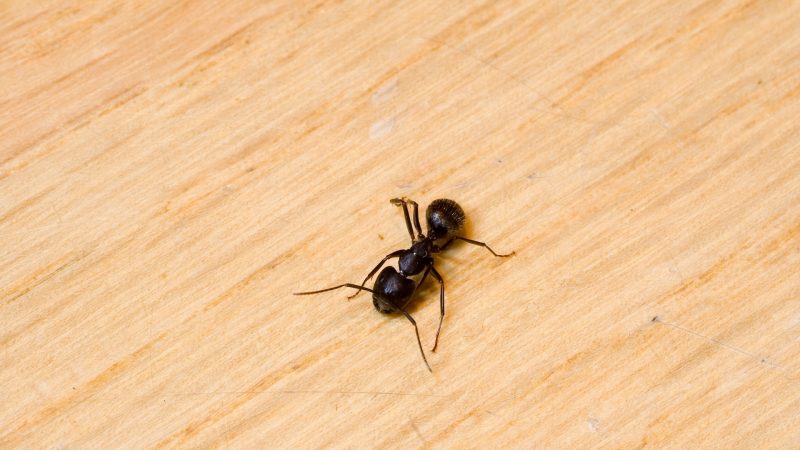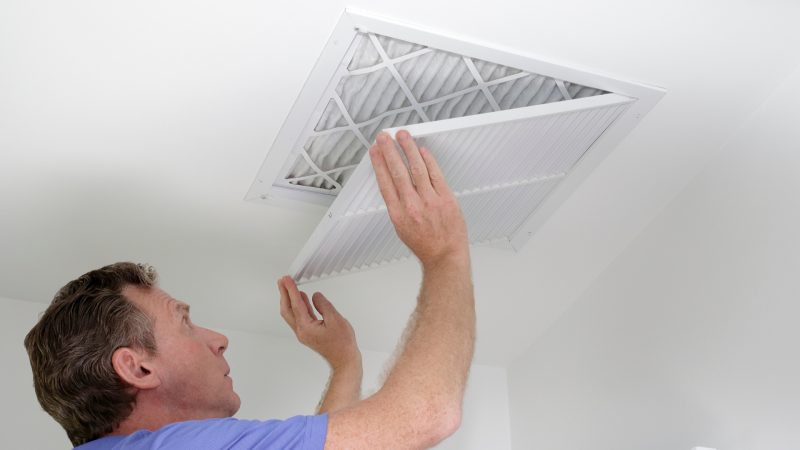Carpenter ants can appear anywhere in your home, even in the ceilings. These little insects can enter and exit any small gaps and cracks, causing potential damage to your property. Carpenter ants, in particular, are known for causing structural damage to the wooden infrastructures of your home.
How to get rid of carpenter ants in the ceiling? To get rid of carpenter ants in the ceiling, you first need to inspect the area and locate their colony. After that carefully prepare and place the ant bait (gel) along the ceiling or crevices of the walls. The ants will consume the gel and share it with the colony, which will result in the elimination of the entire carpenter ant colony.
Although they are very different from termites, the potential damage that carpenter ants can do to your property, if left untreated, can lead to the same costly repairs and weakened structures. This is why getting rid of them needs to be your priority. Let’s begin with our guide!
Carpenter Ants on Ceiling | Information
What Attracts Carpenter Ants to Go in My Ceiling?
There are many reasons why there are carpenter ants in your ceiling. Carpenter ants are naturally drawn to wood and sometimes insulation boards. Inspect your ceiling and determine if there are any leaks or water damage done to the wooden areas of your ceiling. Addressing those areas will help with slowing down the spread of the carpenter ant infestation.

As opposed to the myth that carpenter ants eat wood, carpenter ants in fact do not eat wood and only use wood to establish their colonies. Like other species of ants, carpenter ants are attracted to sugary and sweet foods. Therefore, it is important to keep your living space as clean as possible so be sure to clean up any spills, crumbs, or debris to prevent attracting carpenter ants.
Keep an eye out for small holes or crevices that ants can travel through. You can use sealants to completely seal off their paths or call an expert to seal them.
Can Carpenter Ants Get into Tongue and Groove Ceiling?
Carpenter ants can get into tongue and groove ceilings. Although not entirely uncommon, carpenter ants can also sometimes build their satellite nests in the joints between tongue and groove ceilings. They may also enter the tongue and groove of the ceiling from tree branches that overhang the roof.
Is It Dangerous to Have Carpenter Ants in the Ceiling?
Depending on your situation and infestation extremity, carpenter ants in your ceiling can be dangerous for your property if the infestation is left untreated for an extended period. The longer the carpenter ant infestation is left untreated, the more likely it will spread throughout your home and not just your ceiling.
However, severe cases of carpenter ant infestation are usually infestations that have lasted for several years. Additionally, carpenter ants love to chew on wood. Carpenter ants can weaken the infrastructure of your ceiling, especially if they are wooden panels, which can lead to expensive and timely repairs.
Can Carpenter Ants Create Holes in the Ceiling?
If your ceiling is made of wood, insulation panels, or other soft materials, there are chances that carpenter ants can create holes in your ceiling. Carpenter ants chew through these materials, leaving behind sawdust and sometimes holes in the ceiling.
How Did Carpenter Ants Get in Your Ceiling?
Due to their small size, carpenter ants can travel through the smallest cracks in your ceiling. If you see ants coming out of a hole or crack in your ceiling, be sure to seal it off properly to avoid letting them in.
You can also try inspecting the exterior of your property to see where they may be entering from.
Related: How Strong Are Ants? | Incredible Strength Explained
Signs of Carpenter Ants in Ceiling
Usually seeing live ants inside your home is the first indication of ants there. The likelihood of seeing insulation heaps, sawdust, or ants climbing up the walls, however, increases if you have ants in your ceiling. One explanation is that ants usually build their nests in roofs where there has recently been a leak or water damage.
It will contain wood shavings and dead insects if there are material stacks on the floor. The insulation, which is often white to brown, will fall instead if the ants are chewing through the foam in the ceiling.
How to Get Rid of Carpenter Ants in Ceiling | Instructions
The hollowness and darkness are what make the ceiling such an appealing nesting area for carpenter ants to build their colonies. The height of your ceiling is no hindrance for carpenter ants due to their incredibly sticky feet. Carpenter ants can climb on the highest ceilings with ease.

Leaving a carpenter’s ant infestation untreated for a long period may result in multiple colonies and later cause detrimental damage to your ceiling and home. There are many ways to keep carpenter ants away from your ceilings depending on the extremity of the infestation.
The most common way to get rid of an ant infestation in your ceiling is to maintain the condition of your ceiling. If the infrastructure of your ceiling or house is wooden, make sure that there are no rotting or damp spots.
Carpenter ants build colonies in already wet or rotten wood. Keeping the wood dry and protected, will prevent the carpenter ants from expanding their colony. Now let’s start with our step-by-step guide on how to get rid of carpenter ants in ceilings:
Step 1: Inspection of the Property
Carefully inspect your ceiling and look for any indications of a carpenter’s ant infestation. Look for trails of sawdust and wood shavings that may appear.
If you detect faint scratching sounds coming from your ceiling, this may also be proof of a carpenter’s ant infestation. You might also visually see carpenter ants crawling out of crevices or cracks in your ceiling.
Step 2: Appropriate Insecticide | Ant Baits, Gels & Sprays
After locating the satellite nest of your carpenter’s ant infestation, you can apply insecticide to the desired area. Depending on your ceiling height, some methods may be more challenging than others.
Make sure to wear protective equipment prior to application. Also, keep pets or children away when using insecticides to treat the ant infestation. Insecticides come in various forms such as ant baits, gels, and liquid sprays.
Ant Baits
One of the most common ways to tackle carpenter ant infestations is to use ant baits. The majority of ant baits in the United States contain borax, which is an inexpensive and potent way to get rid of your ant infestation.
Ant baits work by attracting worker ants to carry the poison bait back to the colony. They will share it with the other ants including the queen.
This results in effectively eliminating the population within several days’ time. Be sure to promptly remove any other food source to let the ants only feed on the ant bait.
Ant baits come in several forms. Gel ant baits such as Syngenta Advion Ant Gel or adhesive bait stickers such as Raid Max Double Control Ant Baits are effective baits to lure out carpenter ants.
- ANT CONTROL: Advion Ant gel bait from Syngenta is a...
- EFFORTLESS APPLICATION: This odorless ant bait can easily be...
- TARGETS ALL MAJOR SPECIES: This ant bait effectively controls...
- EFFICIENT ANT CONTROL: Say a quick goodbye to ants with Advion...
- COMPACT PACKAGING: This ant killer gel package comes with 30-gram...
- Two types of bait to attract and kill ants
- After ants feed on the bait, they return to the colony and...
- Population reduction can be expected within days, with the baits...
- For household use: Closets, basements, attics, living areas,...
- Child-resistant
If you see that there are ant trails on the ground, TERRO T300B Liquid Ant Bait Ant Killer is another effective ant bait for carpenter ants you find on the ground.
- ATTRACTS & KILLS: TERRO liquid ant baits indoor effectively...
- KILLS THE ANTS YOU DON'T SEE: TERRO ant bait is designed to share...
- FAST-ACTING: Noticeable ant activity reduction within days as...
- READY TO USE: Simply place ant baits indoors with no setup...
- VERSATILE HOME PLACEMENT: TERRO ant traps are ideal for use along...
Related: Best Carpenter Ant Baits: Reviews & Guide | Indoor and Outdoor
Insecticide Spray
You may also choose to use a liquid insecticide spray if the entrance of the colony, their ant trails, or any holes they crawl through are visible and within your reach. Liquid insecticide sprays work immediately and will eliminate carpenter ants instantly. Insecticide sprays such as TERRO T1901-6 Carpenter Ant & Termite Killer and Hot Shot HG-4480 work effectively and quickly as spot treatments.
- Kills Wood-Infesting Insects - Effectively kills carpenter ants,...
- Fast Acting & Long Lasting - This convenient aerosol spray kills...
- Don't Miss Your Target - The two-way spray nozzle allows for...
- Non-Staining, Odorless Formula - This non-staining spray leaves...
- Use Indoors & Outdoors - Spray around windows, doors, and entry...
- KILLS A VARIETY OF ANTS: Kills Argentine, southern, field,...
- KILLS ON CONTACT: Hot Shot Ant Killer Plus aerosol kills on...
- ALSO KILLS COMMON HOUSEHOLD INSECTS: Also kills cockroaches,...
- FOR INDOOR AND OUTDOOR USE: Spray Hot Shot Ant Killer Plus both...
- AEROSOL SPRAY: This water-based, unscented formula leaves no oily...
Do not use ant baits with any other forms of insecticides in the same area since the insecticides will repel the carpenter ants away from the ant bait, making both methods ineffective. If you decide to use both methods, be sure to use a non-repellent insecticide along with the ant bait.
Step 3: Aftermath
After the application of insecticides, be sure to keep small children and pets away from the treated areas. Assure that your space is well-ventilated. Continue to keep your ceiling well-maintained and monitor the carpenter ant activity as much as possible.
Related: Do Dead Ants Attract More Ants? | The Play-Dead Phenomenon!
Carpenter Ant in Ceiling Exterminator: Should You Call a Pest Control Company?
If you find that the carpenter’s ant infestation is still developing or that your ceiling is at an unreachable height, it is advised that you call a professional pest control service to resolve the issue and for them to suggest safeguards against future infestations.
List of Sources
Klotz J. H., Rust M. K., and Hansen L. D., Carpenter Ants, University of California, Agriculture & Natural Resources
Jacobs S., Carpenter Ants, Penn State Extension
Sharpe K. & Klass C., Integrated Pest Management for Carpenter Ants, University of Connecticut, College of Agriculture, Health, and Natural Resources
Potter M., Carpenter Ants, University of Kentucky, College of Agriculture, Food and Environment
Carpenter Ants, National Pesticide Information Center
Carpenter Ants, University of Minnesota Extension
- How to Get Rid of Copperheads | Practical Guide - August 27, 2023
- How to Get Rid of Corn Snakes | What Makes Them Aggressive? - August 27, 2023
- How to Get Rid of Alligators | Safety Measures and Removal Methods - July 16, 2023






